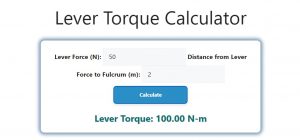About Lever Torque Calculator (Formula)
Torque is a fundamental concept in mechanics, representing the rotational force applied to an object around a pivot point, known as the fulcrum. The Lever Torque Calculator is a useful tool for calculating torque in systems involving levers, which are commonly used in engineering, physics, and everyday tasks. Understanding how to calculate torque helps in optimizing designs, ensuring safety, and improving efficiency in mechanical systems. In this article, we will explore the formula for calculating lever torque, how to use the calculator, and provide examples along with frequently asked questions.
Formula
The formula for calculating lever torque is:
Lever Torque = Lever Force (N) × Distance from the Lever Force to the Fulcrum (m)
In this formula:
- Lever Torque represents the torque exerted on the lever.
- Lever Force (N) is the force applied to the lever in newtons.
- Distance from the Lever Force to the Fulcrum (m) is the perpendicular distance from the line of action of the force to the fulcrum in meters.
How to Use
Using the Lever Torque Calculator is straightforward. Here’s how to effectively use it:
- Determine the Lever Force: Identify the force applied to the lever, measured in newtons (N).
- Measure the Distance: Measure the distance from the point where the force is applied to the fulcrum, expressed in meters (m).
- Input the Values: Enter the lever force and the distance into the calculator.
- Calculate the Torque: Click the calculate button to determine the lever torque.
- Interpret the Result: Review the calculated torque value to understand its effect on the lever system.
Example
Let’s consider a practical example. Suppose you have a lever with a force of 50 N applied 2 meters from the fulcrum.
- Values:
Lever Force = 50 N
Distance from the Lever Force to the Fulcrum = 2 m - Using the Formula:
Lever Torque = Lever Force × Distance
Lever Torque = 50 N × 2 m
Lever Torque = 100 Nm
In this case, the lever torque exerted on the lever is 100 Nm, indicating the effectiveness of the applied force at the specified distance.

FAQs
- What is torque?
Torque is the measure of rotational force applied to an object around a pivot point. - How is lever torque different from regular force?
Lever torque considers both the force applied and the distance from the fulcrum, while regular force only considers the magnitude of the applied force. - What units are used for torque?
Torque is typically measured in newton-meters (Nm) in the metric system. - Can torque be negative?
Yes, torque can be negative, indicating the direction of rotation is opposite to the defined positive direction. - What happens if the distance is zero?
If the distance from the fulcrum is zero, the torque will also be zero, as no rotational force is applied. - How do I increase the torque on a lever?
You can increase torque by applying more force or by increasing the distance from the fulcrum. - What is the role of the fulcrum in lever systems?
The fulcrum serves as the pivot point around which the lever rotates, influencing the mechanical advantage. - Can the Lever Torque Calculator be used for any lever type?
Yes, it can be used for various lever types, including first, second, and third-class levers. - What is mechanical advantage?
Mechanical advantage is the factor by which a lever amplifies the applied force, calculated as the ratio of output force to input force. - How does the length of the lever affect torque?
A longer lever arm increases the distance from the fulcrum, which increases torque for the same applied force. - Can I use this calculator for non-linear applications?
The calculator is primarily designed for linear lever applications, but concepts of torque can apply in rotational systems. - What are some practical applications of lever torque?
Lever torque is used in tools like wrenches, seesaws, and various machines that rely on rotational forces. - Is torque only important in mechanical systems?
No, torque is also crucial in biological systems, such as understanding human movement and joint mechanics. - What are the common mistakes in calculating torque?
Common mistakes include incorrect measurements of force or distance and neglecting the angle of force application. - How can I improve the efficiency of a lever system?
To improve efficiency, minimize friction at the fulcrum and ensure proper alignment of the lever and applied force. - What is the relationship between torque and rotational speed?
Torque and rotational speed are related; higher torque at lower speeds can be advantageous in applications requiring high starting force. - Can I use the calculator for multiple forces?
The calculator is designed for a single force; for multiple forces, calculate the total torque by summing the individual torques. - What factors affect torque in a lever system?
Factors include the applied force, distance from the fulcrum, and the angle at which the force is applied. - How is torque related to energy?
Torque is related to energy as it describes the rotational work done; work is the product of torque and the angle of rotation. - Is torque important in sports?
Yes, understanding torque can improve performance in sports, such as optimizing swings in golf or baseball.
Conclusion
The Lever Torque Calculator is an essential tool for anyone needing to understand and calculate torque in lever systems. By applying the formula and using the calculator effectively, you can determine the torque exerted on a lever and its implications in various applications. Mastering torque calculations enhances your ability to analyze mechanical systems, optimize designs, and ensure safety and efficiency in engineering and everyday tasks.